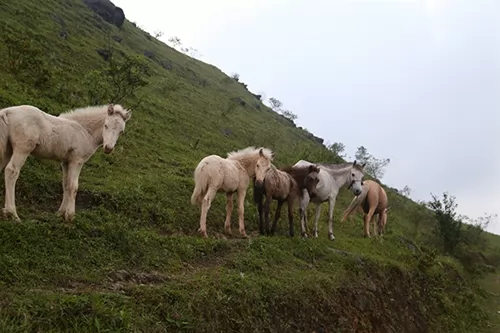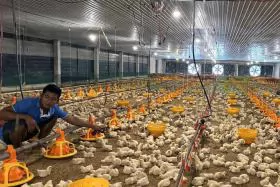Cross-breeding, piloting many new varieties of plants and animals

The Center for Plant Breeding (Department of Agriculture and Rural Development) has successfully cross-bred aromatic banana by tissue culture.
(BGO) - Determining agriculture as an important production sector that contributes to local socio-economic development, in recent years, Bac Giang province has implemented programmes to support the cross-breeding, demonstration and experimentation, and successfully apply many new kinds of plants and animals, creating a breakthrough in productivity and quality.
Increasing productivity, quality
In the past spring crop, the Bac Giang Seed Joint Stock Company cooperated with the Divisions of Agriculture and Rural Development in nine districts and city in producing the pure rice variety P15 on a total area of over 100 hectares. As a result, this variety has outstanding advantages in terms of quality and resistance to pests.
Tran Van Sy, Chairman of the Tan Dinh Agriculture Cooperative (Lang Giang district), said: "The locality grew this rice variety on 15 hectares, yielding 6.5 tonnes per ha, higher than that of the rice variety KD18. Meanwhile, the grain is big, full and firm, with high quality, aromatic smell and delicious taste".
In this summer crop, the Divisions of Agriculture and Rural Development of districts and city have collaborated with the Bac Giang Seed Joint Stock Company to expand the area of the pure rice variety P15 to more than 165 hectares. The localities will continue to evaluate the results, aiming to expand production and put the rice variety into the main seed structure instead of other rice varieties which are gradually degrading.
Not only changing rice varieties, early this year, in Tu Lan commune (Viet Yen district), the provincial Union of Science and Technology Associations has successfully deployed the project "Pilot breeding of olive tree skink (Dasia olivacea)".
Accordingly, more than 1,000 skinks were given to the family of Nguyen Van Cuong in Thuong village. After five months of care, the animals grow fast and strongly while feed cost is very low because skinks only eat insects such as: mosquitoes, spiders and grasshoppers.
Currently, he has sold the products for 350,000-400,000 VND per kg. Recognizing that this type of animal brings in high economic efficiency and wins the market’s favor, some households in the region have come to his home to study the model.
Especially, in the past two years, the Agricultural Extension Centre under the provincial Department of Agriculture and Rural Development and the Center for Application of Scientific and Technological Advances under the provincial Department of Science and Technology have successfully cross-bred and piloted many varieties of plants and animals with high productivity and quality. They include crispy carp, mixed cow, Mura buffalo, new breed eucalyptus, old roses and marbled eel.
Selecting new varieties, applying high technology
The project of breeding olive tree skinks in Tu Lan commune (Viet Yen) generates high income.
According to Nguyen Duc Kien, Director of the provincial Department of Science and Technology, in recent five years, each year the province had from 35 to 50 science and technology projects at all levels, costing about 100 billion VND (4.3 million USD), most of which were in the field of hi-tech agriculture.
Many projects, after proven, have been replicated, contributing to the formation of many specialised commodity agricultural production areas with high productivity, quality and income such as growing green asparagus and aquaculture in Viet Yen and Yen Dung districts; growing medicinal plants in Yen Dung, Son Dong, Tan Yen and Lang Giang districts; growing fruit trees and breeding livestock and poultry in Luc Ngan, Yen The and Tan Yen district; rice and vegetable fields in Yen Dung, Hiep Hoa and Lang Giang districts.
In order to well implement the projects, from the beginning, the provincial Council of Science and Technology has selected capable units to participate in. Each project which has been proven to be feasible and suitable for local climate and soil conditions will be multiplied.
For example, for the project of producing medicinal plants in Tan Yen and Lang Giang provinces, after being proven to show high efficiency and be suitable for local climate and soil conditions, the department advised the provincial People's Committee to expand the project to Yen Dung and Luc Nam districts with a budget of nearly 1.5 billion VND (64,370 USD). Some districts have their own support mechanisms to help locals replicate new models.
In the coming time, the Department of Science and Technology will continue to select and implement projects to cross-breed, produce and pilot new varieties in order to create a set of quality varieties in the production structure of the people. It will focus on building brands and labels for local products toward linking chains, ensuring sales of products and improving economic efficiency.
Hoang Phuong
Maybe you are interested

Animal welfare: Emerging concept and application that needs to be promoted in Việt Nam
Some key aspects of animal welfare include that animals can have freely access to sufficient and good-quality water and feed, he said, adding that animal welfare also refers to freedom of stress and fear and natural behaviours so that animals can express

Vietnam chicken farming sector grapples with surge in imports
Many chicken farmers in Vietnam have suffered losses over the past three years and are on the verge of bankruptcy due to high imports.

In the kingdom of Hữu Kiên white horses
HÀ NỘI — When talking about travel to the northern province of Lạng Sơn, you may think of the historic Chi Lăng Passage which used to be the barrier protecting Việt Nam from Chinese invaders or the famous Nhất Thanh-Nhị Thanh-Tam Thanh caves.






